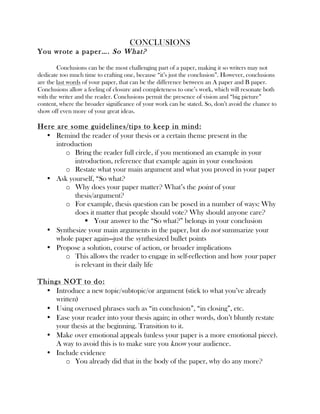
Tillie - Conclusions
- 1. CONCLUSIONS You wrote a paper…. So What? Conclusions can be the most challenging part of a paper, making it so writers may not dedicate too much time to crafting one, because “it’s just the conclusion”. However, conclusions are the last words of your paper, that can be the difference between an A paper and B paper. Conclusions allow a feeling of closure and completeness to one’s work, which will resonate both with the writer and the reader. Conclusions permit the presence of vision and “big picture” content, where the broader significance of your work can be stated. So, don’t avoid the chance to show off even more of your great ideas. Here are some guidelines/tips to keep in mind: • Remind the reader of your thesis or a certain theme present in the introduction o Bring the reader full circle, if you mentioned an example in your introduction, reference that example again in your conclusion o Restate what your main argument and what you proved in your paper • Ask yourself, “So what? o Why does your paper matter? What’s the point of your thesis/argument? o For example, thesis question can be posed in a number of ways: Why does it matter that people should vote? Why should anyone care? § Your answer to the “So what?” belongs in your conclusion • Synthesize your main arguments in the paper, but do not summarize your whole paper again—just the synthesized bullet points • Propose a solution, course of action, or broader implications o This allows the reader to engage in self-reflection and how your paper is relevant in their daily life Things NOT to do: • Introduce a new topic/subtopic/or argument (stick to what you’ve already written) • Using overused phrases such as “in conclusion”, “in closing”, etc. • Ease your reader into your thesis again; in other words, don’t bluntly restate your thesis at the beginning. Transition to it. • Make over emotional appeals (unless your paper is a more emotional piece). A way to avoid this is to make sure you know your audience. • Include evidence o You already did that in the body of the paper, why do any more?